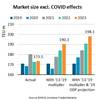Sentiment is often a somewhat flighty and nebulous concept, but it appears that crude oil markets are turning increasingly bullish about the prospect for higher prices.
Certainly the mood at this week's major industry conference in Singapore was a marked change from recent years, with several upbeat presentations, panel discussions and off-the-record chats giving the view that prices were more likely to rise than fall.
The most bullish commentary at the Asia Pacific Petroleum Conference (APPEC) was from trading house Trafigura, whose co-head of group market risk, Ben Luckock, said the era of prices being lower for longer was coming to an end, and the market would be in a supply deficit of between 2 and 4 million barrels per day (bpd) by the end of 2019.
Luckock was joined by several other market players at the S&P Global Platts event in being optimistic that a new cycle of rising prices was starting.
But scratch beneath the bullish views and a different picture emerged.
A snap electronic poll of the conference participants showed a majority of just under 70 percent believed oil prices would remain locked in a $50-$60 range for 2018, with only 10 percent seeing a breakout to the upside.
That is basically where crude prices are currently, with Brent at $57.64 a barrel and U.S. benchmark West Texas Intermediate at $51.99 in early Asian trade on Thursday.
Effectively, if you were to take away an impression of the APPEC conference, Asia's most significant oil event, it would be that market participants felt a lot better about the state of crude markets, without having much faith that prices would mount a sustainable rally.
That's largely because the risks to a sustained price rally seem larger than the drivers currently.
There are three main areas of uncertainty clouding the outlook for crude prices, two on the supply side and one on demand.
On supply, whether the Organization of the Petroleum Exporting Countries (OPEC) and its allies extend their combined 1.8 million bpd output cuts beyond the March 2018 expiry is a key uncertainty.
While there is debate as to how effective the cuts have actually been in re-balancing the market, any sign that OPEC and its allies, including major exporter Russia, are ending their production discipline, would be taken as bearish for prices.
There is also concern that the high compliance with the cuts that OPEC claims will start to slip if the Brent price rises above $60 a barrel and shows signs of staying there.
U.S. SHALE IS KEY DISRUPTOR
The other supply issue is how quickly U.S. shale drillers can respond to higher prices, and how effectively any extra production can reach global markets.
While there appears consensus on the view that U.S. shale oil producers have the ability to increase their output at fairly short notice, it's less certain that the U.S. Gulf Coast has enough export infrastructure to handle a surge of cargoes.
Only the Louisiana Offshore Oil Port has the ability to load the largest oil tankers, and that is only likely to start early next year.
Currently U.S. crude exports are either on smaller tankers, which are relatively costly to operate on long routes to Asia, or the cargoes are transferred at sea to a bigger vessel, a process that can add around $2 a barrel to shipping costs to the major consuming region of Asia.
On the demand side, it's clear that middle distillates have led prices higher so far this year on the back of stronger industrial growth in major consumers such as China and India.
The increase in demand will likely boost overall crude consumption by 1.6 to 1.7 million bpd this year, Janet Kong, BP's chief executive, supply and trading, Eastern Hemisphere, told the Singapore conference on Tuesday.
But whether this demand growth is sustainable is also a key uncertainty, with question marks over whether Chinese policy makers will continue with stimulus, or whether they will ease off the infrastructure and construction spending that has driven fuel consumption.
Overall, the renewed bullish sentiment in the market is a bet that global oil inventories will continue to drain as a result of both OPEC output cuts and stronger demand, and that this process will happen faster than U.S. shale and other producers outside the OPEC agreement can bring on new supplies and get them to market.
By Clyde Russell













